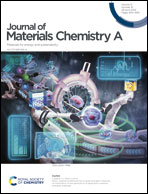Bionic inspired multifunctional modular energetic materials: an exploration of new generation of application-oriented energetic materials†
Abstract
The balance between pertinence and universality of high value-added energetic materials has gained importance in recent years. Inspired by the efficient working mechanism of stem cells, an innovative energetic material concept, multifunctional modular energetic materials (MMEMs), with the ability of quantity production and multifunctional uses was first proposed. A machine learning-assisted high-throughput screening system was developed and applied to guide the discovery of MMEMs, and promising energetic compounds were rapidly targeted and synthesized. These compounds exhibited a satisfactory density, thermal properties, detonation performance and sensitivity. Furthermore, they can be easily synthesized to maintain the “energetic stem cell pool” and can undergo “differentiation” for functioning as various compounds such as crystal explosives, cast explosive carriers, energetic binders, and plasticizers through different processing forms/different formulae as needed. It is anticipated that the findings of this study will open up a new research direction of application-oriented energetic materials.



 Please wait while we load your content...
Please wait while we load your content...